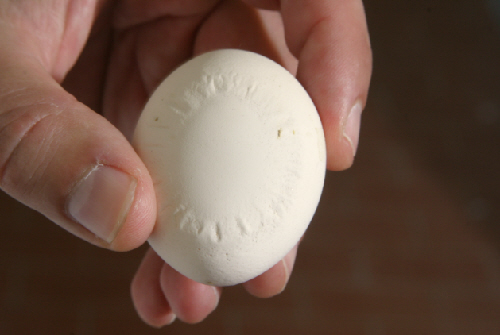



Learning from the Shape and Texture of Hatching Eggs
The shape and texture of the shells is a good reflection of the health and well being of the breeder flock, explains Marleen Boerjan, Director of R&D at the Pas Reform Academy.Eggshell is a well-organised structure, arranged in a matrix of organic matter (proteins) and a palisade layer of crystalline calcium carbonate columns. Between these columns, funnel-shaped openings - pores - are formed, which facilitate the exchange of gas, including water vapour, during the development of the embryo. The outer surface of the shell is covered by a waxy cuticle that protects the eggs from dehydration and invasion by micro-organisms.
From arrival in the shell gland, it takes approximately 20 hours for the egg’s shell to form completely. Albumen and shell membranes have developed while the yolk, with its embryo (blastoderm) on top, travelled through the magnum and isthmus, in the upper part of the hen’s oviduct. The shell gland is the part of the oviduct that secretes a highly concentrated solution of different minerals: calcium chloride, sodium bicarbonate, sodium chloride, potassium chloride and proteins. Shell formation begins with the precipitation of calcium carbonate crystals and glycoproteins on the outer shell membrane.
Calcium carbonate crystals are deposited at a constant rate of about 0.33g per hour. To facilitate smooth, regular shell formation, the egg rotates in the shell gland. Any disturbance of this rotation, for example when the female encounters an aggressive male during mating, produces abnormally formed shell. The shape and texture of the shells is therefore a good reflection of the health and well being of the breeder flock.
This understanding is valuable to hatchery managers, not only to help evaluate the quality of the eggs delivered to the hatchery, but also to have valid input into discussions with breeder farm managers about ways in which to improve hatching egg quality.
It is important to remember the influence of flock age on egg (shell) quality. Older flocks lay larger eggs with thinner shells - and the number of misshapen shells increases.
Poor hatching egg shell quality often results in increased weight loss and decreased hatchabilities, with an increased risk of cracks during handling leading to dehydration and contamination.
Broadly, there are three major classes of shell abnormality:
- Rough, sand paper-like shells point to a delayed oviposition. Environmental farm factors, e.g. too high a temperature or a cold draught, can cause retention of the egg in the oviduct while additional calcium deposition occurs. This can lead to brittle, pink-coloured shells.
- Misshapen eggs are usually the result of a disturbance of the deposition of calcium carbonate in the shell gland by (viral) disease or stress. Irregular ovulation in young flocks, as well as stress or disease in the hen, can influence shell quality and result in misshapen eggs, such as the flat sided example shown in the photo below.
Another type of misshapen eggs are so called 'body checks': eggs that have broken and repaired in the shell gland. Externally, this is visible by a thickened ring around the egg. Conditions in the farm-house, for example fighting between birds, cold draughts or high temperatures, can influence the external appearance of the shells in a batch of eggs. - White, pigment-less shells often are the result of viral infections, like Infectious Bronchitis (IB), Egg Drop syndrome or Avian Influenza. IB eggs are not only white, but also have abnormal shapes and albumen quality is often affected, with thick albumen becoming thin and watery.

Advice
- Score the general appearance of eggshells: good, medium, poor, from each batch of hatching eggs that arrives at the hatchery.
- Perform a detailed analysis of 450 eggs, if general appearance scoring is poor.
- Contact the breeder farm manager or supplier if three per cent or more of eggs are classified as poor.
- Use this simple classification as a guide for discussions with suppliers about egg quality.
June 2014











